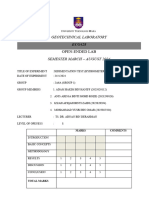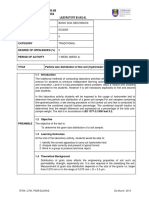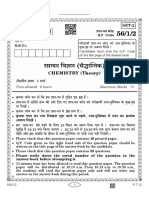Particle Density Ecg 428
Particle Density Ecg 428
Uploaded by
Aiman SyafiqCopyright:
Available Formats
Particle Density Ecg 428
Particle Density Ecg 428
Uploaded by
Aiman SyafiqOriginal Title
Copyright
Available Formats
Share this document
Did you find this document useful?
Is this content inappropriate?
Copyright:
Available Formats
Particle Density Ecg 428
Particle Density Ecg 428
Uploaded by
Aiman SyafiqCopyright:
Available Formats
FAKULTI KEJURUTERAAN AWAM
UNIVERSITI TEKNOLOGI MARA
SHAH ALAM LABORATORY MANUAL
COURSE NAME
COURSE CODE
OPEN-ENDED LAB
SEMESTER
TITLE OF EXPERIMENT : Particle Density
DATE OF EXPERIMENT : 8 APRIL 2021
NAME : Muhammad Aiman Syafiq Bin Isma Samsulzamani
UiTM NO :2020853552
CLASS GROUP :EC2202A3
LECTURER : DR. Nurul Ainain Binti Mohd Salim
LEVEL OF OPENESS :1
MARKS COMMENTS
INTRODUCTION
BASIC CONCEPTS
METHODOLOGY
RESULTS&ANALYSIS 1 2 3 4 5
DISCUSSION 1 2 3 4 5
CONCLUSION 1 2 3 4 5
ORGANIZATION 1 2 3 4 5
TOTAL MARKS
©FKA, UiTM, SHAH ALAM May 2020_mm
FAKULTI KEJURUTERAAN AWAM
UNIVERSITI TEKNOLOGI MARA
SHAH ALAM LABORATORY MANUAL
COURSE GEOTECHNICAL LABORATORY
COURSE CODE ECG428
LEVEL OF OPENNESS 1
CATEGORY PARTIALLY OPEN
DEGREE OF OPEN-ENDED (%) 1
ENGINEERING PROPERTIES
PARTICLE DENSITY
(With reference to clause 7 of BS1377: Part 7: 1990)
Introduction
The traditional methods of conducting laboratory activities will not be able to
provide the avenue for students to enhance independent learning activities and
inculcate creativity and innovation. Level 0 is fully prescriptive where problems,
ways & means and answers are provided to the students. However, it is still
necessary especially to first- and second-year students.
Specific gravity, Gs is defined as the ratio of the weight of a certain volume of soil
solids to the weight of an equal volume of distilled water at a constant temperature,
i.e. it is the most accurate method.
Objectives
PREAMBLE To determine the specific gravity of soil using density bottles.
Learning Outcomes
At the end of the laboratory activities, students would be able to:
1. Acquire the understanding of engineering properties of soils in determination
of the unconfined compressive strength
2. Acquire the necessary skill to prepare sample and conduct force measuring
device and the axial deformation gauges in performing standard laboratory
3. Calculate and analyze data to report and present result in a proper engineering
format.
PROBLEM Specific gravity flask or pycnometer methods are only suitable for coarse grained
STATEMENT soils.
Apparatus
Density bottle will stop having a capillary hole at its center, wash bottle, de-aired
distilled water, alcohol, ether balance, vacuum sets, constant temperature water
bath, etc.
WAYS & MEANS
Procedure
1. Density bottle and stopper had been cleaned and dried properly.
2. Recorded the weight of dried bottle and stopper as m1.
©FKA, UiTM, SHAH ALAM May 2020_mm
FAKULTI KEJURUTERAAN AWAM
UNIVERSITI TEKNOLOGI MARA
SHAH ALAM LABORATORY MANUAL
3. About 10 to 20 grams of oven-dried soil sample that been cooled had been put
carefully in density bottle. After that the mass of the density bottle had been
recorded as m2.
4. About 10 ml de-aired distilled water had been poured into bottle to soak the soil
and rested for 2 to 10 hours.
5. More distilled water had been added into the bottle to make it half full.
Entrapped air inside the bottle had been removed by applying partial vacuum.
6. Gently added some more water into the bottle until full without left any
entrapped bubbles then put the stop on.
7. The bottle had been keep on the stand in a constant temperature water bath for
one hour.
8. Took out the bottle from the water bath and wiped it to clean and dried the
outside. If the capillary of the stopper was not full, filled it with drops of distilled
water. Then, ensure the bottle and stopper were cleaned and dried.
9. Recorded the mass of bottle filled with water and soil with a stopper as m3.
10. The bottle had been emptied and cleaned properly. Distilled water had been
filled fully into the bottle and no entrapped air bubble exist in the bottle. If there is
air bubble partial vacuum needed to be used.
11. The stopper had been put on as in step 8 and outside had been wiped dried. The
mass had been recorded as m4 then emptied the bottle and cleaned it again.
12. step 2 to 11 had been repeated for other two observation to obtain the average
G of the sample.
Specific Gravity of Soil
RESULTS
The specific gravity should be calculated at a temperature of 27oC and reported to the
nearest 0.01. If the room temperature is different from 27oC, the following correction
should be done: -
G’ = kG
where,
G’ = Corrected specific gravity at 27oC
k = [Relative density of water at room temperature]/ Relative density of water at 27oC.
©FKA, UiTM, SHAH ALAM May 2020_mm
FAKULTI KEJURUTERAAN AWAM
UNIVERSITI TEKNOLOGI MARA
SHAH ALAM LABORATORY MANUAL
Sample Calculation:
Specific gravity:
1- 28.57 – 18.57 / (84.74 – 18.57) - (90.88 – 28.57)
= 2.59
2- 28.50 – 18.50 / (84.00 – 18.50) – (90.20 – 28.50)
= 2.63
3- 28.62 – 18.62 / (84.83 – 18.62) – (91.02 – 28.62)
=2.62
Average gravity ( at 31°c)
(2.59 + 2.63 + 2.62) / 3 = 2.61
Specific Gravity (at 27°C)
G’ = kG
DATA ANALISIS G’ = 0.996542(2.61)
= 2.60
The average specific gravity obtain from the result is 2.60. this indicated the
CONCLUSION
volume of voids contain inside the soil.
The density of the minerals that make up individual soil particles determines the
basic gravity of the soil. It basically tells you how much heavier or lighter a
substance is than water. This test involves determining the specific gravity of soil
solids using the pycnometer process, which involves weighing oven-dried soil and
water. The specific gravity was determined using the formula shown in the sample
DISCUSSION AND
measurement, which is the ratio of the mass of a unit volume of soil at a given
RECOMENDATION
temperature to the mass of the same volume of gas-free distilled water at the
same temperature. While conducting this lab, we need to ensure the is no
entrapped bubble trap inside the bottle. We also need to calibrated the balance
before star taking measurement to avoid any reading errors.
©FKA, UiTM, SHAH ALAM May 2020_mm
You might also like
- Determination of Moisture Content Lab ReportDocument4 pagesDetermination of Moisture Content Lab ReportKaty Perry100% (2)
- Cec 108 Prac-Geology - Soil MechnicsDocument36 pagesCec 108 Prac-Geology - Soil MechnicsVietHungCao89% (9)
- w1 Lab SoilDocument5 pagesw1 Lab SoilNabilah HudaNo ratings yet
- LEVEL 0 - Week 2 - Moisture Content N Particle DensityDocument5 pagesLEVEL 0 - Week 2 - Moisture Content N Particle Densitymuiz azihNo ratings yet
- LAB 1 - PARTICLE DENSITY - MOISTURE CONTENT (Level 0)Document7 pagesLAB 1 - PARTICLE DENSITY - MOISTURE CONTENT (Level 0)Doris AsmaniNo ratings yet
- LAB 1 - PARTICLE DENSITY & MOISTURE CONTENT (Level 1)Document6 pagesLAB 1 - PARTICLE DENSITY & MOISTURE CONTENT (Level 1)Muhd MuqhreyNo ratings yet
- Pengajian Kejuruteraan Aw A M UNI Versiti Teknologi Mara Laboratory ManualDocument5 pagesPengajian Kejuruteraan Aw A M UNI Versiti Teknologi Mara Laboratory ManualNor HakimNo ratings yet
- Hydrometer Test Ecg 428Document6 pagesHydrometer Test Ecg 428Aiman SyafiqNo ratings yet
- Ecg303 - Basic Soil Mechanics (Laboratory) : Uitm PahangDocument6 pagesEcg303 - Basic Soil Mechanics (Laboratory) : Uitm PahangNurin AdlinaNo ratings yet
- lab ecg 263 (1)Document10 pageslab ecg 263 (1)2022468934No ratings yet
- Course NameDocument5 pagesCourse NameAiman SyafiqNo ratings yet
- Cone Penetration Ecg428Document9 pagesCone Penetration Ecg428Aiman SyafiqNo ratings yet
- Lab 2 CEG454 Particle Density - G2Document8 pagesLab 2 CEG454 Particle Density - G22023600636No ratings yet
- MATCON - Experiment 5 Group 1Document7 pagesMATCON - Experiment 5 Group 1Yolanda SelgaNo ratings yet
- CE 361 Lab ManualDocument23 pagesCE 361 Lab Manualdadziederrick06No ratings yet
- Soil Lab 1 CorrectionDocument15 pagesSoil Lab 1 CorrectionNurul ShafiqahNo ratings yet
- 2a6a - Lab 8 - Group 1 (2a6a) - Ecg428 - Mac24Document10 pages2a6a - Lab 8 - Group 1 (2a6a) - Ecg428 - Mac24Izzah AfiqahNo ratings yet
- 21CVL75 Geotech Manual revised-5-14 WC &SGDocument10 pages21CVL75 Geotech Manual revised-5-14 WC &SGdharangowdas099No ratings yet
- LAB 2 - ATTERBERG LIMIT TEST (Level 0)Document10 pagesLAB 2 - ATTERBERG LIMIT TEST (Level 0)Doris AsmaniNo ratings yet
- 07 Che247 Cooling TowerDocument16 pages07 Che247 Cooling Tower2024568653No ratings yet
- Mapua University: Experiment No. 1Document8 pagesMapua University: Experiment No. 1Denver John TejadaNo ratings yet
- Lab Manual EcgDocument11 pagesLab Manual EcgHazeyyNo ratings yet
- Specific Gravity DeterminationDocument9 pagesSpecific Gravity DeterminationcortellaptopNo ratings yet
- EXP3 - Specific Gravity (v3)Document7 pagesEXP3 - Specific Gravity (v3)Nur Naqiyah Binti YunusNo ratings yet
- Dayuday Lab02Document5 pagesDayuday Lab02Guhan DayudayNo ratings yet
- LAB 8 - Compaction - LEVEL 2 - AINUR NASUHA BINTI MOHAMMAD RODZI-2019892466Document8 pagesLAB 8 - Compaction - LEVEL 2 - AINUR NASUHA BINTI MOHAMMAD RODZI-2019892466Ainur NasuhaNo ratings yet
- Mini Project Ecg263: Muhammad Najmi Najhan Bin Mohd Azhan J4EC1104A2 2020488778 Wan Syarizawani Binti Wan ChikDocument13 pagesMini Project Ecg263: Muhammad Najmi Najhan Bin Mohd Azhan J4EC1104A2 2020488778 Wan Syarizawani Binti Wan ChikMUHAMMAD AKMAL MD ALINo ratings yet
- Observation #3Document1 pageObservation #3Christian James Hortillano MangomaNo ratings yet
- Expt 2SG Fine AggregatesDocument5 pagesExpt 2SG Fine AggregatesZumir IshratNo ratings yet
- Soil Lab Report - ActiveDocument5 pagesSoil Lab Report - ActivehhazimabNo ratings yet
- Mapua University: Experiment No. 1Document7 pagesMapua University: Experiment No. 1Denver John TejadaNo ratings yet
- GT Lab Manual CBCS 2018Document92 pagesGT Lab Manual CBCS 20181JT19CV013 MedheshNo ratings yet
- Mapua University: Experiment No. 2 Specific Gravity of Soil SolidsDocument10 pagesMapua University: Experiment No. 2 Specific Gravity of Soil SolidsMike SyNo ratings yet
- 05 - Grain Size AnalysisDocument4 pages05 - Grain Size AnalysisAubrey Lynn BarreraNo ratings yet
- Specific GravityDocument9 pagesSpecific GravityikhwanNo ratings yet
- Home Work Chapter 3,4,5Document16 pagesHome Work Chapter 3,4,5CuongNo ratings yet
- Experiment 4 CHM45LDocument3 pagesExperiment 4 CHM45LMaria Ariane DavidNo ratings yet
- Soil Laboratory Testing Report by A K JHADocument127 pagesSoil Laboratory Testing Report by A K JHAAnupEkboteNo ratings yet
- Atterberg Limit TestDocument8 pagesAtterberg Limit Testamyshalianis04No ratings yet
- GT Lab Manual - RevisedDocument74 pagesGT Lab Manual - Revisednishanthvishwa2000No ratings yet
- Geo Labiratory ReportDocument15 pagesGeo Labiratory ReportArarsa FayisaNo ratings yet
- LAB 4 - PSD-WET SIEVING (Level 0) - HYDROMETER (Level 0)Document11 pagesLAB 4 - PSD-WET SIEVING (Level 0) - HYDROMETER (Level 0)Doris AsmaniNo ratings yet
- Lab 4 - Hydrometer Testnvxjkcvbcxckvbckjvjkvknvck.Document6 pagesLab 4 - Hydrometer Testnvxjkcvbcxckvbckjvjkvknvck.Amirah ShafeeraNo ratings yet
- Week 3 (2) - HYDROMETER (Level 0)Document5 pagesWeek 3 (2) - HYDROMETER (Level 0)Mohd YusriNo ratings yet
- Geotech 1 Lab ManualDocument17 pagesGeotech 1 Lab ManualAs fans AwanNo ratings yet
- U03 D Specific Gravity TestDocument10 pagesU03 D Specific Gravity TestLee Z QiNo ratings yet
- Pengajian Kejuruteraan Awam Universiti Teknologi Mara Pa Laboratory Manual PaDocument8 pagesPengajian Kejuruteraan Awam Universiti Teknologi Mara Pa Laboratory Manual PaNor HakimNo ratings yet
- CMT Experiment 1Document5 pagesCMT Experiment 1Mika Vernadeth SingNo ratings yet
- Exp 1lab PavmentDocument9 pagesExp 1lab PavmentHisham AlshormanNo ratings yet
- Mapua University: Experiment No. 1Document11 pagesMapua University: Experiment No. 1Geojanni PangibitanNo ratings yet
- Fluidized Bed Heat Transfer-MSTDocument10 pagesFluidized Bed Heat Transfer-MSTsukhmaniNo ratings yet
- Soil Mechanics Lab Laboratory Manual: Dev Bhoomi Institute Chakrata Road, Navgaoun Manduwala, UttarakhandDocument34 pagesSoil Mechanics Lab Laboratory Manual: Dev Bhoomi Institute Chakrata Road, Navgaoun Manduwala, UttarakhandsunilNo ratings yet
- LAB 5 Permeability TestDocument9 pagesLAB 5 Permeability TestHanis RahamanNo ratings yet
- Laboratory Sand Cone TestDocument12 pagesLaboratory Sand Cone TestScribdTranslationsNo ratings yet
- Determination of Specific GravityDocument9 pagesDetermination of Specific GravityWilmer FernandezNo ratings yet
- 02 Moisture Content of AggregatesDocument4 pages02 Moisture Content of AggregatesStevenNo ratings yet
- Exp 5 DayondonDocument7 pagesExp 5 DayondonDanzel C DayondonNo ratings yet
- CMT LabDocument14 pagesCMT LabJericho SarapaoNo ratings yet
- The Science of Superhydrophobicity: Enhancing Outdoor Electrical InsulatorsFrom EverandThe Science of Superhydrophobicity: Enhancing Outdoor Electrical InsulatorsNo ratings yet
- Summative Test Module 2 - First QuarterDocument2 pagesSummative Test Module 2 - First Quarteranna marie mangulabnan100% (1)
- Oxidation StatesDocument1 pageOxidation StatesDerekChaoNo ratings yet
- Fta Oil+gasdistilcolumn PDFDocument7 pagesFta Oil+gasdistilcolumn PDFPrasanna GNo ratings yet
- 1-J Mater Chem A2014217297-17301Document5 pages1-J Mater Chem A2014217297-17301heydaripostNo ratings yet
- Application of Surfactants in The Petroleum Industry: Those Uses AreDocument4 pagesApplication of Surfactants in The Petroleum Industry: Those Uses AreGeeva Prasanth A100% (1)
- Determination of PH of Soils by Different Methods: Collaborative StudyDocument15 pagesDetermination of PH of Soils by Different Methods: Collaborative StudyMelanie ChawNo ratings yet
- Composites Part B: SciencedirectDocument11 pagesComposites Part B: SciencedirectSavina LaísNo ratings yet
- Technical AATccDocument48 pagesTechnical AATccomi sun100% (1)
- Download ebooks file Soil and water chemistry an integrative approach Second Edition Essington all chaptersDocument81 pagesDownload ebooks file Soil and water chemistry an integrative approach Second Edition Essington all chaptersyavusdhyani100% (1)
- Product List De-Shalom Pharm-Wps OfficeDocument3 pagesProduct List De-Shalom Pharm-Wps OfficeiwezejoNo ratings yet
- CAPE Chemistry 2007 U1 P2Document11 pagesCAPE Chemistry 2007 U1 P2Lilian RegeNo ratings yet
- Polymers 14 04402 v2Document22 pagesPolymers 14 04402 v2Ahmed FouadNo ratings yet
- Design of Distillation ColumnDocument31 pagesDesign of Distillation ColumnDEEP HIRPARA100% (1)
- BTech CSE 2018-2022 Jul-2020Document80 pagesBTech CSE 2018-2022 Jul-2020Adhara MukherjeeNo ratings yet
- Method of AnalysisDocument37 pagesMethod of Analysisisaiah mathengeNo ratings yet
- Research Paper On Purification by SublimationDocument6 pagesResearch Paper On Purification by SublimationGurdevNo ratings yet
- Hardness Autosaved 1Document13 pagesHardness Autosaved 1Rabinn HoodNo ratings yet
- Quantitative Prediction of Long-Term Failure of PoDocument10 pagesQuantitative Prediction of Long-Term Failure of PomarymagvichillNo ratings yet
- Unit 5 - Acids Bases and Salts Teacher VersionDocument37 pagesUnit 5 - Acids Bases and Salts Teacher VersionAmadu sallieuNo ratings yet
- Chiappetta 2007Document15 pagesChiappetta 2007Imene MechkourNo ratings yet
- Comfort Aspects of Finished Polyester-Cotton and Polyester-Viscose Ring and MJS Yarn FabricsDocument7 pagesComfort Aspects of Finished Polyester-Cotton and Polyester-Viscose Ring and MJS Yarn FabricsAditya ShrivastavaNo ratings yet
- TYBSc Redox TitrationsDocument80 pagesTYBSc Redox Titrationsmyebooks.pramodNo ratings yet
- Preparation, Synthesis and Application of Sol-Gel Method: October 2020Document33 pagesPreparation, Synthesis and Application of Sol-Gel Method: October 2020SMIT CHRISTIANNo ratings yet
- 56 1 2 ChemistryDocument19 pages56 1 2 ChemistryParth SaxenaNo ratings yet
- The Copper Cycle - Fall 2023Document6 pagesThe Copper Cycle - Fall 2023CakeMaster7No ratings yet
- RinchipaperDocument10 pagesRinchipaperpraveenpalanivel098No ratings yet
- Revised First Term Date Sheet & Syllabus XII 2024-25Document6 pagesRevised First Term Date Sheet & Syllabus XII 2024-25ywywhshs58No ratings yet
- Soal Toefl 2Document5 pagesSoal Toefl 2Acu Yanto100% (1)
- Semi ProposalDocument6 pagesSemi ProposalDawit AbameNo ratings yet
- Water and Papermaking 2 White Water ComponentsDocument11 pagesWater and Papermaking 2 White Water ComponentsMiguelNo ratings yet

























































































